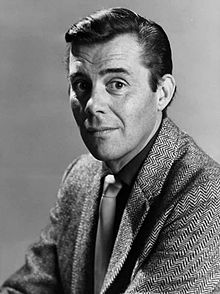
Back Dirk Bogarde Afrikaans Dirk Bogarde AN ديرك بوجاردي Arabic ديرك بوجارد ARZ درک بوقارد AZB Дърк Богард Bulgarian ডার্ক বোগার্ড Bengali/Bangla Dirk Bogarde Catalan Dirk Bogarde Danish Dirk Bogarde German
Dirk Bogarde | |
|---|---|
 Publicity portrait, 1964 | |
| Born | Derek Jules Gaspard Ulric Niven van den Bogaerde 28 March 1921 West Hampstead, London, England |
| Died | 8 May 1999 (aged 78) Chelsea, London, England |
| Nationality | English |
| Occupations |
|
| Years active | 1939–1990 |
| Partner | Anthony Forwood (1949–1988) (Forwood death)[1] |
| Military career | |
| Allegiance | |
| Service | British Army |
| Rank | Major |
| Battles / wars | World War II |
| Website | dirkbogarde.co.uk (Dirk Bogarde Estate) |
Sir Dirk Bogarde (born Derek Jules Gaspard Ulric Niven van den Bogaerde; 28 March 1921 – 8 May 1999) was an English actor, novelist and screenwriter. Initially a matinée idol in films such as Doctor in the House (1954) for the Rank Organisation, he later acted in art house films, evolving from "heartthrob to icon of edginess".[2]
In a second career, he wrote seven best-selling volumes of memoirs, six novels, and a volume of collected journalism, mainly from articles in The Daily Telegraph. Bogarde saw active military duty during World War Two, and over the course of five years reached the rank of major and was awarded seven medals. His poetry has been published in war anthologies, and a grey ink brush drawing, "Tents in Orchard. 1944", is in the collection of the British Museum.[3]
Having come to prominence in films including The Blue Lamp in the early 1950s, Bogarde starred in the successful Doctor film series (1954–1963). He twice won the BAFTA Award for Best Actor in a Leading Role, for The Servant (1963) and Darling (1965). His other notable film roles included Victim (1961), Accident (1967), The Damned (1969), Death in Venice (1971), The Night Porter (1974), A Bridge Too Far (1977) and Despair (1978). He was appointed a Commander of the Order of Arts and Letters in 1990 and a Knight Bachelor in 1992.
- ^ "Why Dirk Bogarde was a truly dangerous film star".
- ^ Monks Kaufman, Sophie (23 March 2021). "Why Dirk Bogarde was a truly dangerous film star". BBC. Retrieved 13 October 2022.
- ^ "Drawing - 1945,1208.60". British Museum. Retrieved 23 November 2023.